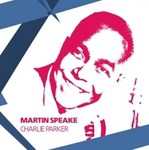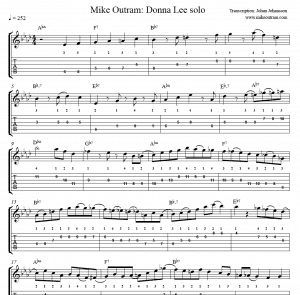Johan Johansson sent me this:
I took down the first chorus of your solo on Donna Lee from Martin Speake’s Charlie Parker album, and it would be interesting to know how you play that in terms of fingering and string-choices. If I send it as a sibelius-file with fingerings, would you mind checking it?
 So I added in the phrasing and fingering, the kind of fingering I’d use if it were me playing it. And, er, it is :)
So I added in the phrasing and fingering, the kind of fingering I’d use if it were me playing it. And, er, it is :)
The track is from the album ‘Charlie Parker’ by Martin Speake and you can hear it on Spotify here. This particular arrangement uses the idea of collective improvising but the entry of each instrument is staggered. So first the sax improvises a chorus, then the guitar joins so it turns into a duet, then the bass joins so it’s a trio and finally the drums enter making a collectively improvising quartet.
Here’s the bit that’s transcribed:
And here’s a PDF of the transcription/TAB DonnaLeeSolo.pdf
 The solo starts out mind-numbingly simple. I’m just outlining the changes using mainly triads. At around bar 9 it starts to get more 8th-notey. I’d normally use more pull-offs and hammer-ons than this but I seem to remember trying to get a more forceful rhythmic feel so I could lock in with Martin (as we’re just playing on our own with no drums) so I pick a bit more than normal.
The solo starts out mind-numbingly simple. I’m just outlining the changes using mainly triads. At around bar 9 it starts to get more 8th-notey. I’d normally use more pull-offs and hammer-ons than this but I seem to remember trying to get a more forceful rhythmic feel so I could lock in with Martin (as we’re just playing on our own with no drums) so I pick a bit more than normal.
Phrasing-wise I use a combination of picking and slurring to try to approximate the kind of phrasing sound that a voice or trumpet might have. Generally that means picking on the upbeats and slurring onto the downbeats. In places that you can’t do that you have to be more dynamic with the pick.
Here are two little exercises to help with that:
- Play constant 8th notes and pick on the upbeats and slur on to the downbeat. Just go all over the neck, improvising with this phrasing sound. This exercise is about getting dynamic phrasing (i.e. not all picked/the same) from slurs, and tied in with that is the guitar’s limitation of having to slur on one string.
- Play a scale and accent the downbeats. Then play the scale but accent upbeats. Make the contrast between accented and non-accented notes as extreme as you can. Make the quiet notes as quiet as you can play (almost inaudible) and the loud notes as loud as you can (like you’re trying to break the strings!). This exercise is about getting dynamic control over the pick.
Thanks to Johan for transcribing it :)
Excellent blog post. Very practical stuff too (doing the exercises now!).
This makes me want to find my mislaid “advancing guitarist” by Mick Goodrick and revisit some of his suggestions.
Thanks, Jake. Glad you like :)